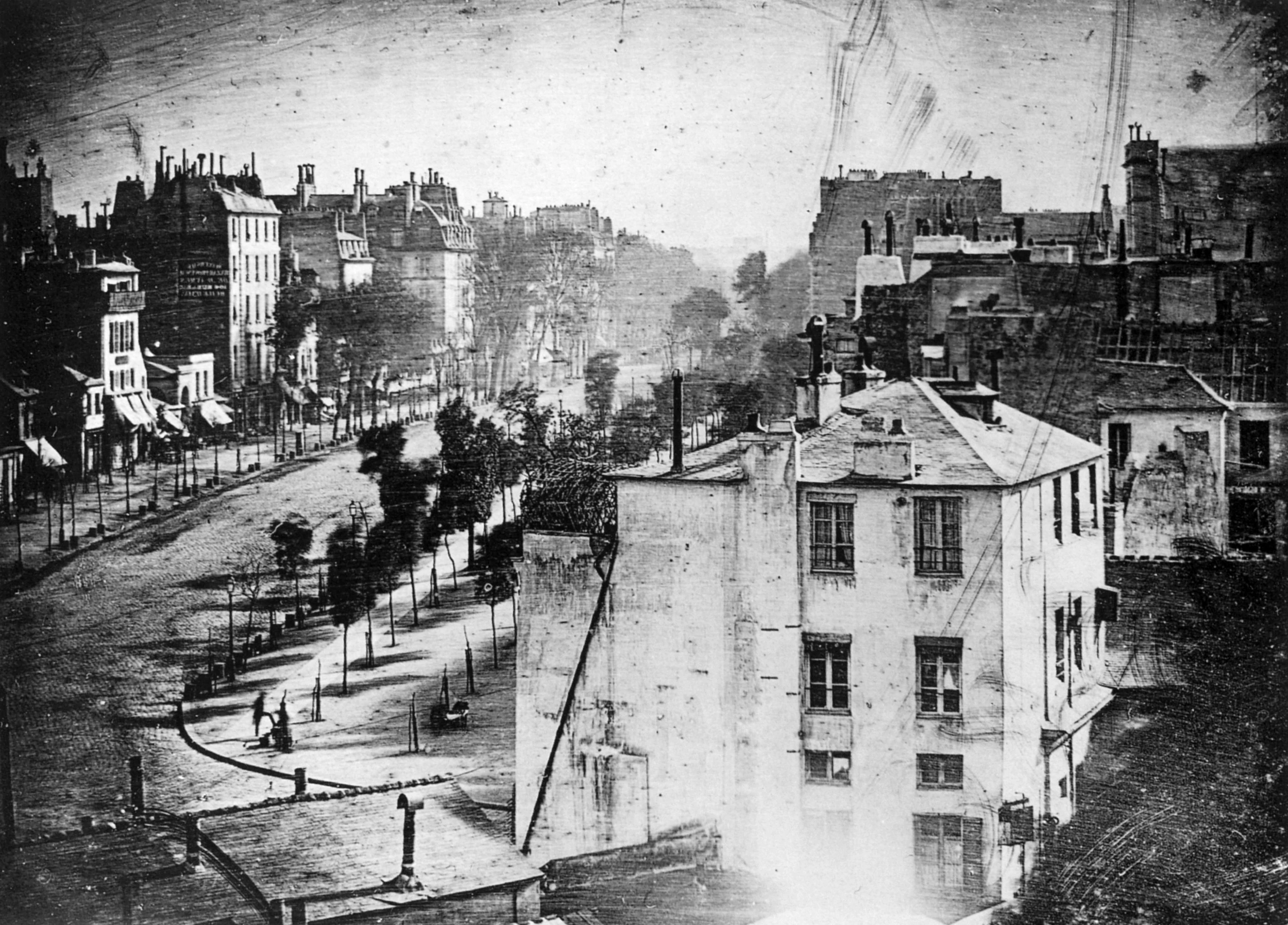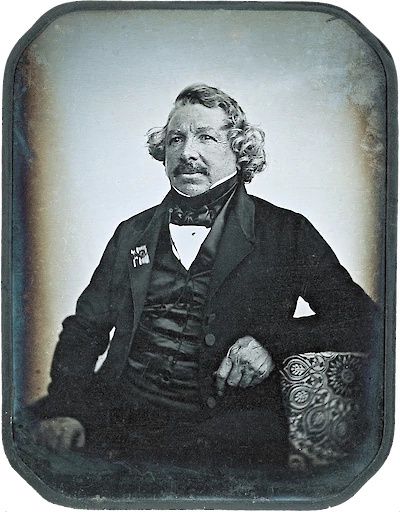

Louis Jacques Mandé Daguerre
Visionary promoter of photography
1787 – 1851[This document describes Louis Daguerre’s adjustments to the Heliographic process invented by Nicéphore Niépce and documented in 1829.]
The substance which ought to be used in preference to Bitumen is the residuum obtained by the evaporation of the essential oil of lavender applied in an extremely thin wash by means of dissolution in alcohol.
Although bituminous and resinous substances without any exception are all endowed with the same property—that of being affected by the influence of light, the preference ought to be.given to those which are the most unctuous, because they impart greater adhesion to the drawings. Several essential oils lose this character when they are exposed to too strong a heat.
It is not, however, from its prompt decomposition, that we are to prefer the essential oil of lavender. There are rosins for instance, which being dissolved in alcohol, and spread upon glass or metal, leave by the evaporation of the spirit, a coating very white, and infinitely more sensible to radiation, which is the cause of the decomposition. But this greater sensibility to light caused by a quicker evaporation, renders also the images thus obtained more liable to injury from the very same agency which created them. They grow faint, and finally disappear altogether, when exposed even but for a few months to the sun. The residuum of the essential oil of lavender, possesses greater fixity, without, however, being altogether impervious to the eroding effects of a direct exposure to the sun’s light.
To obtain this residuum, the essence is evaporated in a shallow dish by heat, till the residuum acquire such consistency, that when cold it rings on being struck with the point of a knife, and flies off in pieces when separated from the dish. A small quantity of this material is afterwards to be dissolved in alcohol, or ether; the solution ought to be very transparent, and of a citron-yellow colour. The clearer the solution, the more delicate will be the coating on the plate: it must not, however, be too clear, because it could not thicken or spread out into a white coat—requisites indispensable for obtaining a good effect in photographic designs. The use of the alcohol in ether is merely to facilitate the application of the residuum under a form of extreme tenuity and division, for the spirit is entirely evaporated before the light impresses its tracery upon the sketch.
In order to obtain greater vigour, the metal ought to be burnished: sketches upon glass have more charm, and above all, much greater delicacy.
Before commencing operations, the experimenter must be careful to have his glass or metal perfectly clean. For this purpose he may use alcohol with emery-powder exceedingly fine, and applied by means of cotton wool; but this part of the process must always be concluded by dry-polishing, that not a trace of liquid may remain.
The tablet being thus prepared, in order to supply the wash or coating, the canvas of the future picture, the plate of metal or glass is held in one hand, and with the other pour upon it the solution, (which for this purpose should be contained in a small flask with a wide mouth) so that it may rapidly flow over, and cover the whole surface of the plate. At first it is necessary to hold the plate a little inclined; but as soon as the solution is poured on, and has ceased to flow, the plate is raised perpendicularly. The finger is then passed behind and below the plate, in order to draw off a portion of the liquid which, tending always to ascend, would double the thickness of the covering; the finger must be wiped each time, and be passed very rapidly along the whole length of the plate from below, and on the side opposite the coating. When the liquid has ceased to run, the plate is put aside to dry in the dark, for otherwise the light would destroy the sensibility of the preparation.
The coating being thus well dried, the plate may be placed in the camera obscura. It is allowed to remain there a sufficient time for the production ofphotographic images—a space which cannot be determinately fixed, because it depends upon the degree of intensity of the light cast upon the objects to be delineated. However, for a landscape, the time cannot be less than seven or eight hours, and about three hours for single monuments or other objects which are strongly illuminated by the sun, or otherwise very bright in themselves. Still these data are but approximations, for the seasons and the different hours of the day produce very considerable modifications of the principles.*
When one operates on glass, it is necessary, in order to increase the light, to place it upon a sheet of paper; but, that this reflection be not confused, we must place the surface opposite the coated side, directly upon the paper, touching it in every point. To accomplish this, we must previously stretch the paper upon a perfectly flat board, having taken care to select a plate, even in its surface, and very white in colour.
When the sketch has remained the proper time in the camera, it is to be withdrawn, care always being taken to protect it from the light.
As it very often happens that on being removed from the camera the plate gives no indication of the images traced upon it, our next operation must be to evoke these hidden forms.
Provide a vessel of tinned copper or sheet-iron larger than your tablet, and having all round a ledge or border 50 millemetres in depth. Fill this three-quarters full with oil of petroleum; fix your tablet by the back to a piece of wood which completely covers the vessel of oil, placing it so that the tablet, face downwards, is over but not touching the oil. In this position the petroleum evaporating, penetrates entirely the coating of the tablet in those places on which the action of the light has been feeble, that is, in the portions of the picture corresponding to the shadows, imparting to them a transparency, as if nothing were there : those points, on the contrary, upon which the light has acted with all its intensity, and which consequently express the lights on the natural objects represented, remain unchanged, because they resist the action of the petroleum.
In this manner, the whole harmony and gradation of tints are brought out by the varied action of the vapour upon the coating of the tablet, in proportion as that has received the impressions of light.
The design must be examined from time to time, and withdrawn as soon as a vigorous effect is obtained. For, in urging the action too far, even the strongest lights will be attacked by the vaporization and will disappear, to the ruin of the piece. The picture being finished, a glass is placed over it as a protection against the dust, which is first to be blown away if any has fallen upon the tablet during the operation. Placing the designs under glass will also preserve the silver plating from being injured by the vapours which blacken or corrode the metal.
It has been remarked above, all bitumens, all resins, and all residua of essential oils are decomposable by light in a very sensible degree: to produce this effect it is only required to spread them in very thin coatings over a proper surface, and to find a solvent which suits them. We may employ as dissolvents oil of petroleum, all the essential oils, alcohol, the ethers, and caloric.
M. Niepce plunged the tablet, covered with a varnish of bitumen, into a liquid solvent. But such a mode of applying the solvent is rarely in harmony with the diminished intensity of the light in photographic sketches obtained by the camera.
It ever happens that the dissolvent is too strong or too weak. In the former case the design is destroyed by the entire removal of the varnish; in the latter, the images are not sufficiently brought out, and the design remains indistinct.
The effect of a solvent into which a photographic design is immerged, produces the removal of the varnish in those points where the solar action has been weak, or indeed according to the nature of the solvent, a contrary effect follows, that is to say, the points strongly acted upon by the solar rays, namely, the lights of the picture, are eroded, while the shadows remain untouched. This takes place for instance when alcohol is used instead of an essential oil as a dissolvent.
Solvents by evaporation or by the effects of caloric are much preferable. Their action can always be arrested at pleasure. But in this case it is indispensable that the ground or coating do not act as a varnish, it must be tough and as white as possible. The vapour of the solvent merely penetrates the coating and destroys its texture, in proportion to the greater or less intensity of the light by which the design was impressed. This manner of operating gives a gradation of tone altogether impossible to be attained by immersing the design in any solvent.
Numerous experiments made by the author prove that light cannot fall upon a body without leaving traces of decomposition on the surface upon which it impinges. But these experiments have also demonstrated to him that these same bodies possess the power of restoring and renewing in a great measure their previous loss in darkness, provided the light has not effected a total decomposition.*
Any one may be convinced of this, by taking two plates, prepared as already described, and exposing them to photographic influences of exactly the same kind and duration. When it is judged that the light has produced its effects, and that both are impressed with the same, or nearly the same imagery, let both be withdrawn from the camera. Let one be now exposed to the immediate action of the dissolvent, but let the other be preserved carefully in the dark for some days, after which let it be subjected also to the solvent It will be seen that the result obtained from the second does not resemble the effects on the first plate.
It may thence be concluded that a large portion of bodies, and without any doubt all varnishes, would perish much more rapidly, but for this property which they possess of renewing in the shade the waste produced in them by the action of light.